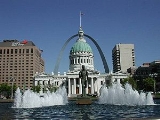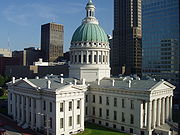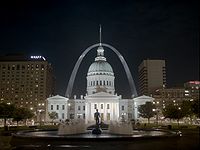
Old Courthouse
Encyclopedia
The Old St. Louis County Courthouse was built as a combination federal and state courthouse
in St. Louis, Missouri
. Missouri's tallest habitable building
from 1864 to 1894, it is now part of the Jefferson National Expansion Memorial
and operated by the National Park Service
used for historical exhibits and events.
and St. Louis founder René Auguste Chouteau
Lucas and Chouteau required the land be "used forever as the site on which the courthouse of the County of St. Louis should be erected." The Federal style courthouse was completed in 1828.
 It was designed by the firm of Lavielle and Morton, which also designed the early buildings at Jefferson Barracks as well as the Old Cathedral. The firm is reported to the first architect firm west of the Mississippi River above New Orleans. Joseph Laveille as street commissioner in 1823-26 was the one who devised the city's street name grid, with ordinal numbers for north-south streets and arboral names for the east-west streets.
It was designed by the firm of Lavielle and Morton, which also designed the early buildings at Jefferson Barracks as well as the Old Cathedral. The firm is reported to the first architect firm west of the Mississippi River above New Orleans. Joseph Laveille as street commissioner in 1823-26 was the one who devised the city's street name grid, with ordinal numbers for north-south streets and arboral names for the east-west streets.
Missouri became a state in 1821, and the St. Louis population tripled in 10 years. A new courthouse was soon needed. In 1839 ground was broken on a courthouse designed by Henry Singleton, with four wings including an east wing that comprised the original courthouse and a three-story cupola
dome at the center. Its overall theme was Greek Revival.
In 1851 Robert S. Mitchell began a redesign, in which the original courthouse portion on the east wing was torn down and replaced by a new east wing. From 1855 to 1858, the west wing was remodeled. The famous Dred Scott
citizenship case was heard in the west wing before the remodeling.
In 1861 William Rumbold replaced a cupola
with an Italian Renaissance
cast iron
Dome modeled on St. Peter's Basilica
in Vatican City
. The United States Capitol
dome, built at the same time during the American Civil War
, is also modeled on the basilica. Once the dome was completed, Karl Ferdinand Wimar
was commissioned to paint murals. The St. Louis dome was completed in 1864.
Rumbold in 1869 was to design the Missouri State Hospital (also called the St. Louis County Insane Asylum or City Sanitarium) which also features a dome. Its location at 5400 Arsenal is the highest point in St. Louis.
Rumbold's dome in the courthouse is wrought and cast iron
with a copper exterior. Four lunette
s in the dome have paintings by Carl Wimar depicting four events in St. Louis history. Ettore Miragoli painted over them in 1880, but they were restored in 1888.
Louis Brandeis
was admitted to the bar in the building in 1878.
The courthouse building was the tallest building in Missouri and St. Louis until 1896 when Union Station (St. Louis) was built.
 When St. Louis County, Missouri
When St. Louis County, Missouri
and the city split in 1877 the courthouse became city property. The courthouse was abandoned by the city in 1930 when the Civil Courts Building
was built. Descendants of Chouteau and Lucas sued to regain ownership. In 1935 St. Louis voted a bond issue to raze nearly 40 blocks around the courthouse in the center of St. Louis for the new Jefferson National Expansion Memorial
. President Franklin Roosevelt declared in an Executive Order the area would be a national monument
. The courthouse formally became part of the new monument area in 1940. Replaced in 1941, the roof was renovated in 1955, 1985, and 2010. The courthouse remained the largest structure in the monument until the Gateway Arch
was built in 1965.
Courthouse
A courthouse is a building that is home to a local court of law and often the regional county government as well, although this is not the case in some larger cities. The term is common in North America. In most other English speaking countries, buildings which house courts of law are simply...
in St. Louis, Missouri
St. Louis, Missouri
St. Louis is an independent city on the eastern border of Missouri, United States. With a population of 319,294, it was the 58th-largest U.S. city at the 2010 U.S. Census. The Greater St...
. Missouri's tallest habitable building
Missouri's Tallest Buildings and Structures
The tallest structures in the U.S. state of Missouri include a broadcasting tower, an chimney, a monument, and a office building.-Missouri's tallest accessible buildings:-Missouri's tallest structures:-Missouri's tallest chimneys:...
from 1864 to 1894, it is now part of the Jefferson National Expansion Memorial
Jefferson National Expansion Memorial
The Jefferson National Expansion Memorial is in St. Louis, Missouri, near the starting point of the Lewis and Clark Expedition. It was designated as a National Memorial by Executive Order 7523, on December 21, 1935, and is maintained by the National Park Service .The park was established to...
and operated by the National Park Service
National Park Service
The National Park Service is the U.S. federal agency that manages all national parks, many national monuments, and other conservation and historical properties with various title designations...
used for historical exhibits and events.
History
Land for the courthouse was donated in 1816 by Judge John Baptiste Charles LucasJohn Baptiste Charles Lucas
John Baptiste Charles Lucas was a member of the U.S. House of Representatives from Pennsylvania.John B. C. Lucas was born in Pont-Audemer, Normandy, France. He attended the Honfleur and Paris Law Schools, and graduated from the law department of the University of Caen in 1782...
and St. Louis founder René Auguste Chouteau
René Auguste Chouteau
Rene Auguste Chouteau , also known as Auguste Chouteau, was founder of St. Louis, Missouri, a successful fur trader and a politician. He and his partner had a monopoly for many years of fur trade with the large Osage tribe on the Missouri River...
Lucas and Chouteau required the land be "used forever as the site on which the courthouse of the County of St. Louis should be erected." The Federal style courthouse was completed in 1828.

Missouri became a state in 1821, and the St. Louis population tripled in 10 years. A new courthouse was soon needed. In 1839 ground was broken on a courthouse designed by Henry Singleton, with four wings including an east wing that comprised the original courthouse and a three-story cupola
Cupola
In architecture, a cupola is a small, most-often dome-like, structure on top of a building. Often used to provide a lookout or to admit light and air, it usually crowns a larger roof or dome....
dome at the center. Its overall theme was Greek Revival.
In 1851 Robert S. Mitchell began a redesign, in which the original courthouse portion on the east wing was torn down and replaced by a new east wing. From 1855 to 1858, the west wing was remodeled. The famous Dred Scott
Dred Scott
Dred Scott , was an African-American slave in the United States who unsuccessfully sued for his freedom and that of his wife and their two daughters in the Dred Scott v...
citizenship case was heard in the west wing before the remodeling.
In 1861 William Rumbold replaced a cupola
Cupola
In architecture, a cupola is a small, most-often dome-like, structure on top of a building. Often used to provide a lookout or to admit light and air, it usually crowns a larger roof or dome....
with an Italian Renaissance
Italian Renaissance
The Italian Renaissance began the opening phase of the Renaissance, a period of great cultural change and achievement in Europe that spanned the period from the end of the 13th century to about 1600, marking the transition between Medieval and Early Modern Europe...
cast iron
Cast iron
Cast iron is derived from pig iron, and while it usually refers to gray iron, it also identifies a large group of ferrous alloys which solidify with a eutectic. The color of a fractured surface can be used to identify an alloy. White cast iron is named after its white surface when fractured, due...
Dome modeled on St. Peter's Basilica
St. Peter's Basilica
The Papal Basilica of Saint Peter , officially known in Italian as ' and commonly known as Saint Peter's Basilica, is a Late Renaissance church located within the Vatican City. Saint Peter's Basilica has the largest interior of any Christian church in the world...
in Vatican City
Vatican City
Vatican City , or Vatican City State, in Italian officially Stato della Città del Vaticano , which translates literally as State of the City of the Vatican, is a landlocked sovereign city-state whose territory consists of a walled enclave within the city of Rome, Italy. It has an area of...
. The United States Capitol
United States Capitol
The United States Capitol is the meeting place of the United States Congress, the legislature of the federal government of the United States. Located in Washington, D.C., it sits atop Capitol Hill at the eastern end of the National Mall...
dome, built at the same time during the American Civil War
American Civil War
The American Civil War was a civil war fought in the United States of America. In response to the election of Abraham Lincoln as President of the United States, 11 southern slave states declared their secession from the United States and formed the Confederate States of America ; the other 25...
, is also modeled on the basilica. Once the dome was completed, Karl Ferdinand Wimar
Karl Ferdinand Wimar
Karl Ferdinand Wimar , was a painter of Western Native Americans and buffaloes....
was commissioned to paint murals. The St. Louis dome was completed in 1864.
Rumbold in 1869 was to design the Missouri State Hospital (also called the St. Louis County Insane Asylum or City Sanitarium) which also features a dome. Its location at 5400 Arsenal is the highest point in St. Louis.
Rumbold's dome in the courthouse is wrought and cast iron
Cast iron
Cast iron is derived from pig iron, and while it usually refers to gray iron, it also identifies a large group of ferrous alloys which solidify with a eutectic. The color of a fractured surface can be used to identify an alloy. White cast iron is named after its white surface when fractured, due...
with a copper exterior. Four lunette
Lunette
In architecture, a lunette is a half-moon shaped space, either filled with recessed masonry or void. A lunette is formed when a horizontal cornice transects a round-headed arch at the level of the imposts, where the arch springs. If a door is set within a round-headed arch, the space within the...
s in the dome have paintings by Carl Wimar depicting four events in St. Louis history. Ettore Miragoli painted over them in 1880, but they were restored in 1888.
Louis Brandeis
Louis Brandeis
Louis Dembitz Brandeis ; November 13, 1856 – October 5, 1941) was an Associate Justice on the Supreme Court of the United States from 1916 to 1939.He was born in Louisville, Kentucky, to Jewish immigrant parents who raised him in a secular mode...
was admitted to the bar in the building in 1878.
The courthouse building was the tallest building in Missouri and St. Louis until 1896 when Union Station (St. Louis) was built.

St. Louis County, Missouri
St. Louis County is a county located in the U.S. state of Missouri. Its county seat is Clayton. St. Louis County is part of the St. Louis Metro Area wherein the independent City of St. Louis and its suburbs in St. Louis County, as well as the surrounding counties in both Missouri and Illinois all...
and the city split in 1877 the courthouse became city property. The courthouse was abandoned by the city in 1930 when the Civil Courts Building
Civil Courts Building
The Civil Courts Building is a landmark court building used by the 22nd Judicial Circuit Court of Missouri in St. Louis, Missouri.The building with its pyramid shaped roof is prominently featured in the center of photos of the Gateway Arch from the Illinois side as its location on the Memorial...
was built. Descendants of Chouteau and Lucas sued to regain ownership. In 1935 St. Louis voted a bond issue to raze nearly 40 blocks around the courthouse in the center of St. Louis for the new Jefferson National Expansion Memorial
Jefferson National Expansion Memorial
The Jefferson National Expansion Memorial is in St. Louis, Missouri, near the starting point of the Lewis and Clark Expedition. It was designated as a National Memorial by Executive Order 7523, on December 21, 1935, and is maintained by the National Park Service .The park was established to...
. President Franklin Roosevelt declared in an Executive Order the area would be a national monument
U.S. National Monument
A National Monument in the United States is a protected area that is similar to a National Park except that the President of the United States can quickly declare an area of the United States to be a National Monument without the approval of Congress. National monuments receive less funding and...
. The courthouse formally became part of the new monument area in 1940. Replaced in 1941, the roof was renovated in 1955, 1985, and 2010. The courthouse remained the largest structure in the monument until the Gateway Arch
Gateway Arch
The Gateway Arch, or Gateway to the West, is an arch that is the centerpiece of the Jefferson National Expansion Memorial in St. Louis, Missouri. It was built as a monument to the westward expansion of the United States...
was built in 1965.
Notable cases
- In 1846 the slave Dred ScottDred ScottDred Scott , was an African-American slave in the United States who unsuccessfully sued for his freedom and that of his wife and their two daughters in the Dred Scott v...
sued for his and his wife's freedom in the building based on the fact that they had lived in free states. All of the trials, including a Missouri Supreme Court hearing, were held in the building. The case was ultimately decided by the U.S. Supreme Court in 1857 Dred Scott v. SandfordDred Scott v. SandfordDred Scott v. Sandford, , also known as the Dred Scott Decision, was a ruling by the U.S. Supreme Court that people of African descent brought into the United States and held as slaves were not protected by the Constitution and could never be U.S...
, which ruled against him. The decision was to polarize the nation in the run up to the American Civil War. - In 1872 Virginia MinorVirginia MinorVirginia Louisa Minor was an American women's suffrage activist. She is best remembered as the plaintiff in Minor v...
attempted to vote in a St. Louis election and was arrested. Her trials, including the deliberations before the Missouri Supreme Court, were held in the building. The case was eventually appealed to the United States Supreme Court in Minor v. HappersettMinor v. HappersettMinor v. Happersett, , was a United States Supreme Court case appealed from the Supreme Court of Missouri concerning the Missouri law which ordained "Every male citizen of the United States shall be entitled to vote."...
, which upheld the male-only voting rules.

